Visit to the
|
| Tom Clark is one stubborn man. I always wanted to start an article with a sentence like that, just to get his attention. I know he is laughing reading it. Of course he freely admits that he is stubborn as hell, so there is nothing new there. However, we'll get back to that later..... On the way to Tom's, I first stopped by Starmaster Telescopes to deliver a 30" f/3.3 mirror. I had a quick dinner with Rick and Carol before heading further south. Next I stopped by Plano, Texas to visit Doug and Christina. Christina owns a 30" f/3.3 Starmaster telescope, and the plan was once again to head out to the Three Rivers Foundation observing site in north central Texas for some observing. Doug and Christina are pictured below with their scopes at that site. 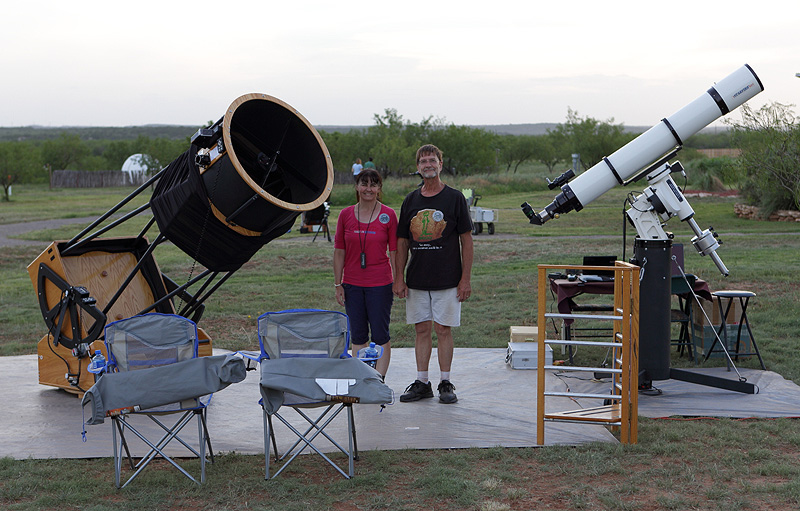 This time we would stay for two nights, Saturday and Sunday, and return on Monday. The weather forecast was not ideal, but looked decent, so we headed out Saturday morning to get set up and be ready for darkness. It was hot and humid on Saturday. This was a bit unusual for this area, since it is normally drier there. The heat made setup quite a toasty experience. The public had been invited out for the Saturday night observing, and it looked like 10-20 people had come for this. As the sun got lower, the clouds tortured us, and we weren't sure if they would subside, cover part of the sky, or completely sock in. I managed to scan around with the 30" f/3.3 and find Jupiter just after sunset, and the members of the public quickly came over and swarmed the telescope. While looking at Jupiter, I was noting some astigmatism in the image. It could have been from a variety of sources, but later on I would try to diagnose it. I knew that the figures of the primary and secondary mirror were not at fault. It was a warm night. We were swatting some mosquitoes and drinking water. We could always go into the meeting room in order to cool off and have a drink or snack. Observing the images as the telescope cooled, the astigmatism was not going away. I rotated the primary to see if the cell or uneven cooling was at fault, but nothing changed. This pointed to a secondary mirror mounting issue. We enjoyed some decent views Saturday night, but the clouds refused to go away, and we turned in before it got too late. The next morning dawned sunny, and we tackled the secondary mirror issue. Now keep in mind, Rick Singmaster tested this telescope out himself and found no issues, so something clearly had shifted or changed since he delivered it. As it turned out, the secondary holder itself, purchased from another vendor, was at fault. I want to note right now that these holders have been updated recently to address the issues that I am about to discuss. The vendor has made significant improvements, and I have seen a recent secondary holder of the same size and it appeared to be greatly improved in a number of ways. Still, these older holders still can have issues, especially for 4.5" m.a. and larger mirrors, so I wanted to show some of the things that we did to fix them, just in case others are experiencing similar astigmatism issues, especially for those with my optics in their telescopes. I have also worked on a 5" m.a. and 5.5" m.a., so I am getting fairly proficient at fixing them. As we disassembled the holder, we noted the lack of a foam plug that takes up much of the volume on the inside of the updated holder. This was because it had some issues with fit, so it was not used. Due to jostling during transport and how the holder fit, the secondary had become wedged in the holder and the tip of the secondary had actually suffered a small chip. This chip does not affect the optical performance, but it illustrates the stress that the mirror had been put under as it shifted in the holder. Below are images showing the lip in non-uniform contact with the secondary mirror near the joint in the holder shell, and the small chip that resulted from the pinching.   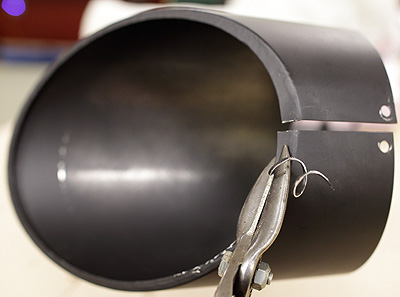 The
shell of the holder needed some adjustment. It was bent to a
shape that was too small for the mirror, and the lip was far too wide,
and could have obscured part of the mirror that should have been
available. This caused the overlap of the lip shown in the
image
above the chip. So, I made some modifications by hand. The
shell of the holder needed some adjustment. It was bent to a
shape that was too small for the mirror, and the lip was far too wide,
and could have obscured part of the mirror that should have been
available. This caused the overlap of the lip shown in the
image
above the chip. So, I made some modifications by hand.I used tin snips to cut away much of the lip that retained the mirror, as shown in the photo at left. Then the lip was filed and sanded smooth to remove the sharp edges created by cutting it. This kept it from abrading the surface of the mirror. Next, I spent a good deal of time enlarging the diameter of the holder so that the mirror could fit in it without being pinched. I also re-bent the lip so that it would uniformly contact the mirror all the way around it. This was patiently and carefully done with pliers and other tools, and by hand. We wrapped tape around the disk of material that the holder shell is bolted to in order to increase its diameter a bit. 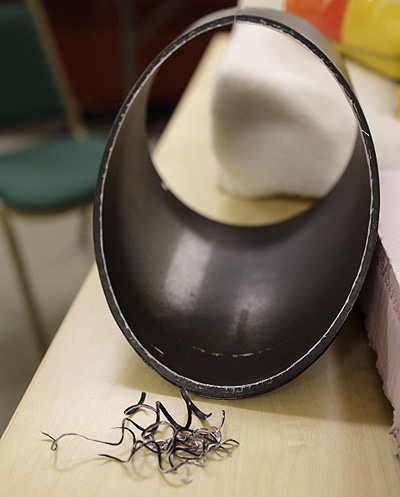 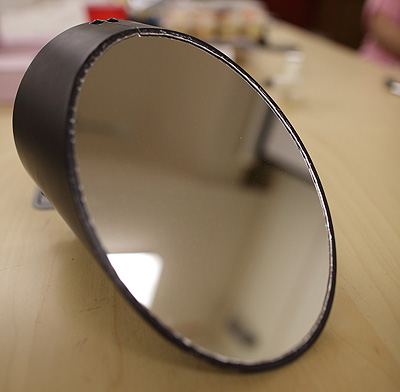 The work took the better part of an afternoon, but was worth it. When the fit looked good, I assembled the holder and did two simple tests. For both tests, I held the holder in my hand with the mirror surface horizontal, so the reflecting surface was facing straight up. First, I shook the holder horizontally, listening for the sound of the mirror tapping against the edge of the holder. This meant that the mirror had freedom of lateral (side to side) movement, and was not pinched/compressed. Second, I carefully moved the holder up and down rapidly so that the mirror could "bounce" up and down within the holder. When I felt it shift down away from the lip and come back up and contact the lip, I knew the pressure from the polyester batting was about right. These holders also have some flexure of the 3/8" rod that the holder attaches to as the telescope is moved up and down, but this has also been addressed in the improved version, so I won't discuss it here, other than to say that shimming metal objects between the spider vanes and metal plate that holds the adjustment screws greatly reduces this flexure. One can also move the holder right up agains the spider, though this will usually require re-drilling of the holes to mount the spider so that the position of the secondary is not changed. The purpose of the foam plug is to fill up most of the empty space inside of the holder so that a thinner, more uniform layer of polyseter batting can be used to exert gentle, uniform pressure on the back of the secondary mirror in order to hold it in place against the retaining lip. In this case, we made our own foam plug using pink foam and some duct tape to hold it together. An approximately 1" thick layer of batting pushes the mirror into place, and allows the dew heater to remain in place. The image below shows the various pieces all ready for reassmbly. It can take several tries to get everything put back together correctly, and one should tighten the screws that hold the shell on carefully, and make sure that everything lines up as they are tightened down. In particular, pay attention to getting the retaining lip even where the ends of the holder meet (at the top of the holder shown in the image below). Do not worry about having a wide gap between the ends of the holder - this leaves room around the secondary so it is not pinched by it. 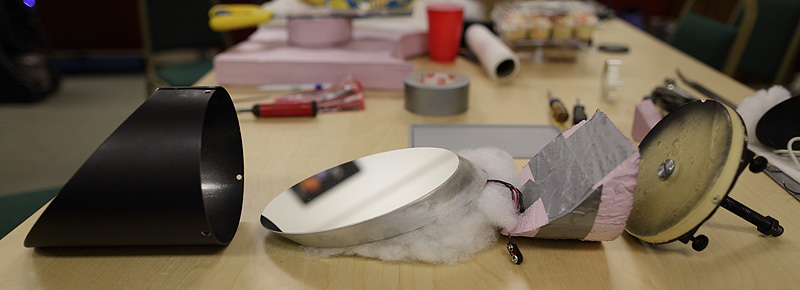 We headed into town (Crowell, TX) for a nice lunch in the middle of this work, and finished everything up in the afternoon. Sunday night was partly cloudy, but it cleared as darkness fell. Lightning flashed distantly in the north. A strong line of storms was ~100 miles away, and could move in our direction. Here is what it looked like just before sunset. 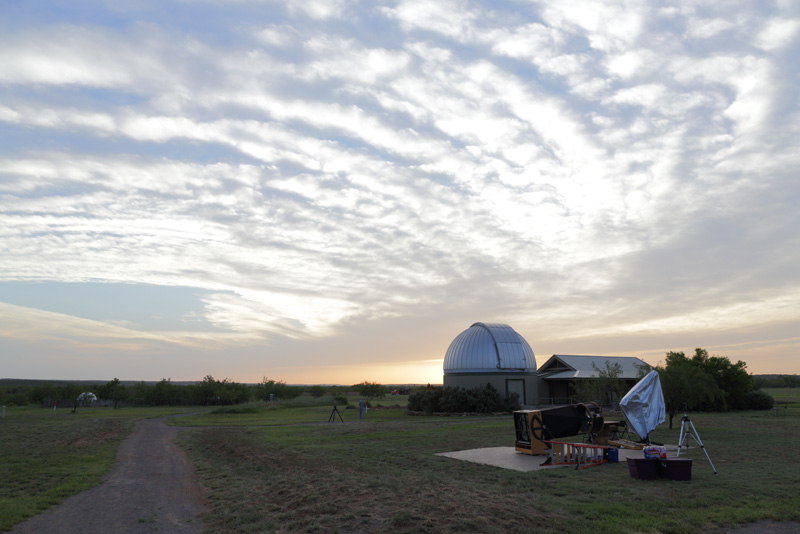 It was very hot, and still. Mosquitoes were everywhere, and I was swatting them all night while observing, shooting photos, etc. If it wasn't for the dark skies above and curiosity about the telescope's performance with the modified holder, I would not have been outside! I bet you're wondering about the images. Well, I can say that after running through all of the usual steps, making sure the primary was not hung up in its cell, making sure collimation was good, etc., the stars were now quite round, and I was pleased. The only thing that I noted was the normal thermal overcorrection that is normal with a mirror that is cooling off. It had been a very hot, sunny day, and this was not a surprise. It is simply normal. We observed a variety of objects in the summer sky, enjoying the performance of a big, high-quality telescope. 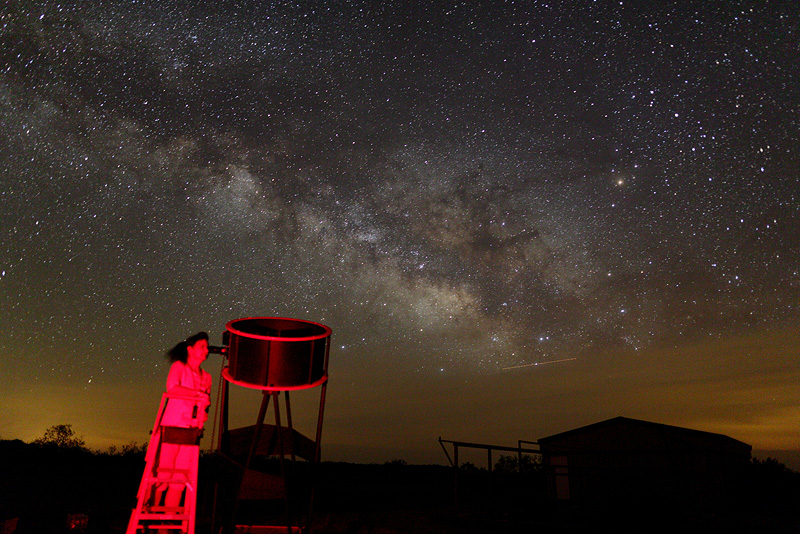 In the image above, Christina observes with her improved 30" f/3.3, now with a secondary holder that is not pinching the mirror. Clouds hang on the southern horizon. A roll-off roof observatory is unused in the background, since Christina's 30" was available. The darkness of this site really is shown by the detail visible within the Milky Way. Around midnight the storms were still flashing in the north, and some clouds obscured the southern horizon, but I shot some very nice images of the summer Milky Way using a fixed tripod and a borrowed iOptron SkyTracker. Below is a ~2 minute shot, but the small size of the images I can use in this web page does not do it justice. It is tight stars all the way down to the original high resolution image. Again, the image illustrates the darkness of this excellent site. 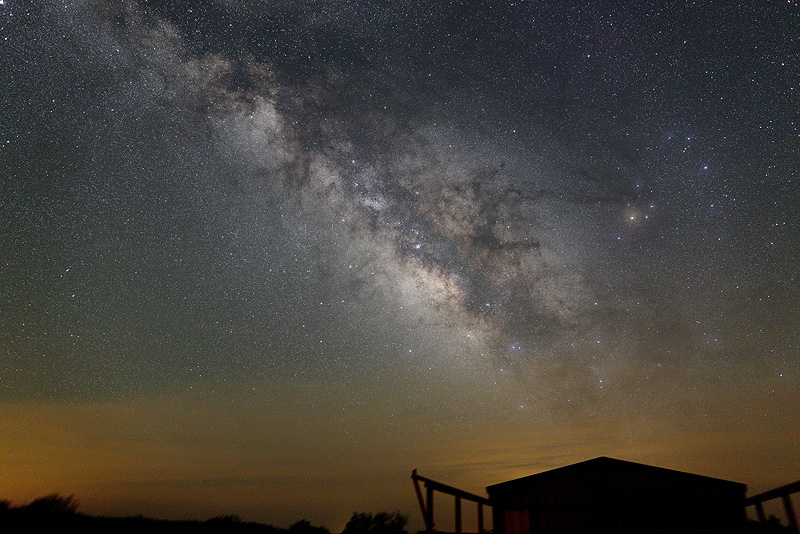 Overnight there was a storm, but with nowhere near the severity of the previous year's hurricane/flood (see that article here). We packed up the telescopes the next morning, trying not to track too much mud into the trailer and truck as we put everything away. Later in the week I joined Doug and Christina at Six Flags Over Texas for some roller coaster riding on a very nice day. Finally, on Friday I gave a talk at a meeting of the Texas Astronomical Society of Dallas. This was a version of my "Why Aren't My Stars Round" article that I also gave at the Winter Star Party earlier this year. It was well received by a large crowd in a very nice university lecture hall (seen in the image below), and I had a number of very good questions to answer. 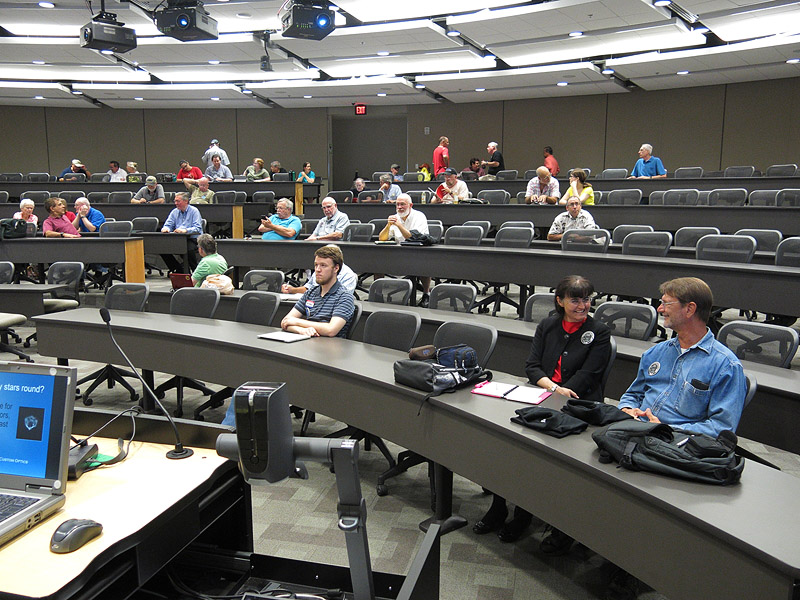 |
Soon afterward I headed for New Mexico, making my first drive through the emptiness of west Texas, which I enjoyed quite a bit. It was mostly uneventful, except for a bad tank of gas that left my car sputtering for a bit across southern New Mexico. After a hotel stay, I arrived in Deming, New Mexico to join Tom and various other friends and neighbors for lunch on Sunday. Then I joined him at his place at the New Mexico Astronomy Village to do some work on the 42" f/3.86 telescope. Below you see the official Lockwood Custom Optics cooler in front of Tom's big dome in the desert. 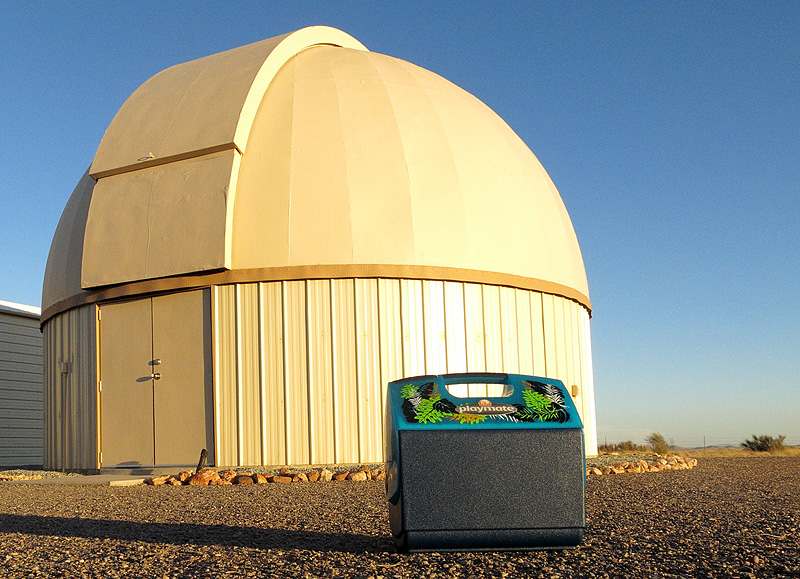 And now we return to Tom's Clark's stubbornness, which I know you are dying to hear more about.... Of course being stubborn has its advantages, such as when you have a telescope design that is good in its day, and you stick with it. However, a 2.2"-thick, 42"-diameter fast mirror requires a bit more than a mirror cell design that was really intended for thicker mirrors. Also, after a complete refiguring of both mirrors and remounting of the secondary with almost no glue, it was time to bring Tom's old 42" mirror cell into the 21st century, since that was one of the last things holding back the telescope's performance. So don't get me wrong - there are many Tectrons out there with mirror cells that work just fine, but this large, thin mirror is a whole different animal. It only took me TWO YEARS to convince Tom to turn his 18-point cell with large, high-friction cork pads and a nylon sling into a 54-point cell with low-friction nylon pads and a modern cable sling positioned at the center of gravity of the mirror. The changes were necessary, though. Simply put, it was the refiguring of the primary mirror that finally revealed the flaws of the cell. The mirror was now better than the cell and produced smaller, tighter star images, so the non-roundness of the images caused by the mirror cell was far more obvious as higher powers began being used in Tom's new dome at the New Mexico Astronomy Village. An additonal contributing factor was likely Tom having cataract surgery on both eyes, which resulted in much better vision and brighter images with truer color, and fewer excuses on the golf course. With improved eyes, it was time for an improved telescope, and all that was left to update was the mirror cell. The mirror was clearly bending due to the nylon-strap sling edge support, and I knew this was only being made worse by the high friction and stiction of the large cork pads. As the strap stretched, the cork did not allow the mirror to settle with it, resulting in strained glass at all altitudes. Additionally, the strap stretches and supports the edge of the mirror unpredictably and unevenly, so the solution was to support the mirror evenly along the center of gravity with an accurately-located cable sling that contacts a bit less than 180 degrees around the bottom of the mirror. Before taking the mirror out, we had a nice night of observing shortly after I arrived. The telescope was performing decently, but there was a strong triangularity seen in the star images, and this was aligned with the tube and thus with the gravity vector. Clearly the cell was warping the mirror in a serious way. After an evening of observing under excellent skies, we decided it was time to get to work. We took the mirror out of the telescope one morning. This is an operation involving two chain hoists, one holding the front of the scope and the other holding the mirror cell as it is tipped down to access the mirror. The mirror is then lifted out by hand and placed on a cart. 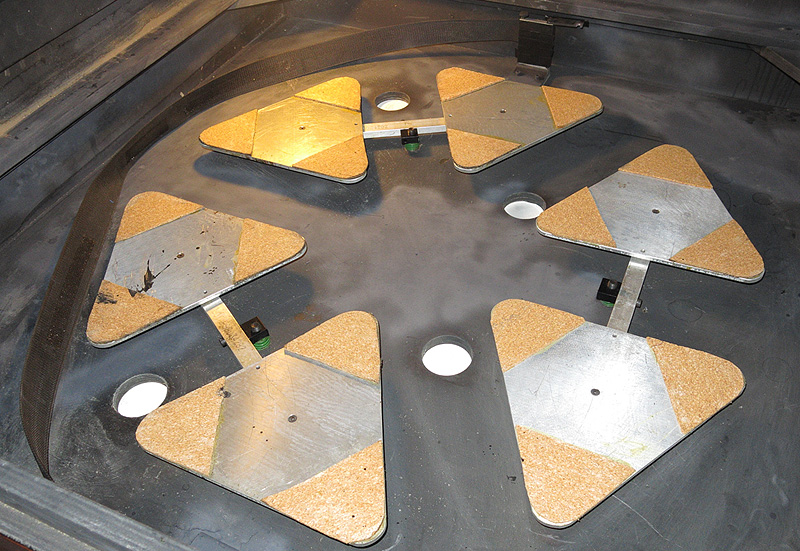 With the cell exposed (see image above showing cork pads and old nylon sling), all of the new parts were installed in about a day. Tom had machined the new triangles, each one replacing a cork pad, ahead of time, and these were affixed to the six old triangles at each corner, thus transforming the 18-point cell into a 54-point cell. Contact points on the new triangles were hex-head nylon bolts with the heads machined flat with Tom's mill. This ensured that they were flat, and that each triangle would make excellent contact with the flat back of the mirror. Next came assembly. With the new triangles attached, below Tom marks the rotational alignment of the triangles after I told him how they should be positioned. 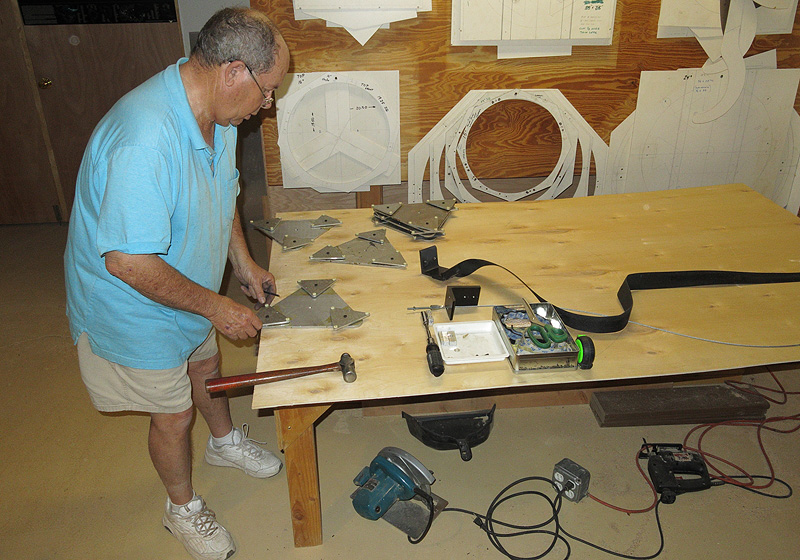 Next, Tom marks and drills holes for roll pins that keep the triangles aligned properly, while allowing them to tilt and evenly support the back of the mirror. 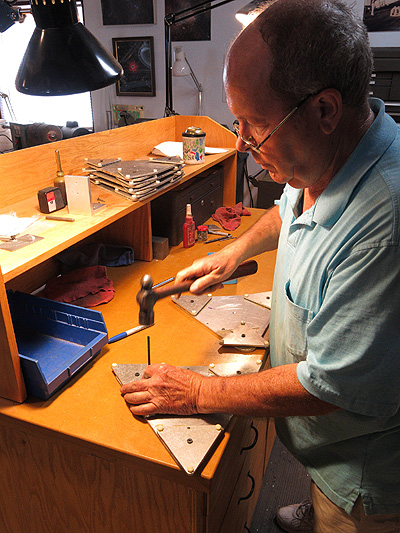 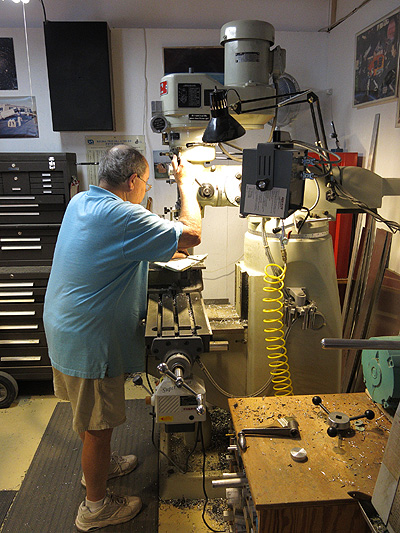 The cable sling was attached to the same brackets that Tom had his nylon strap attached to, but the attachment point had to be carefully located so that the sling was at the center of gravity of the mirror, accounting for the added thickness of the new level of triangles. After much measuring, I finally was happy with the position, and holes were drilled. I attached the threaded pieces at the ends of the cable, carefully cutting the length of the cable after checking it many times. With the new support assemblies back in the cell in the telescope, Tom made a phone call for reinforcements to help put the mirror back in the cell. 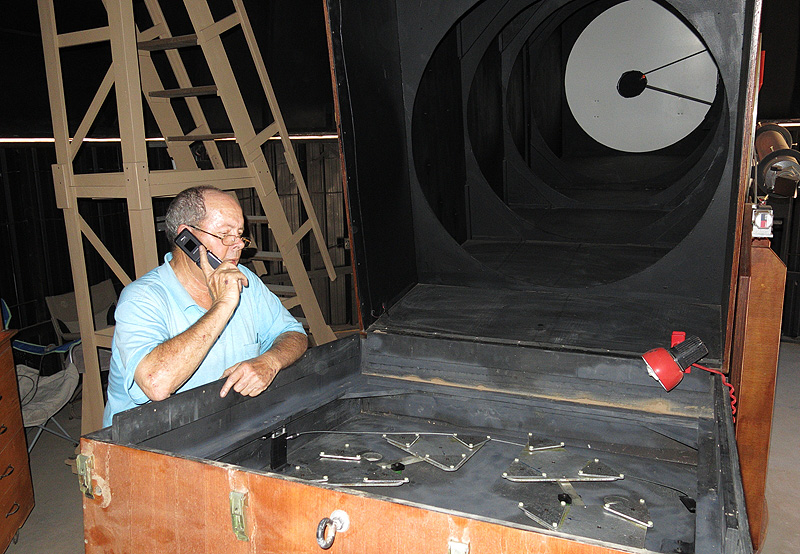 While we waited, Tom snapped a photo of me admiring the new cell. Note the new cable sling. 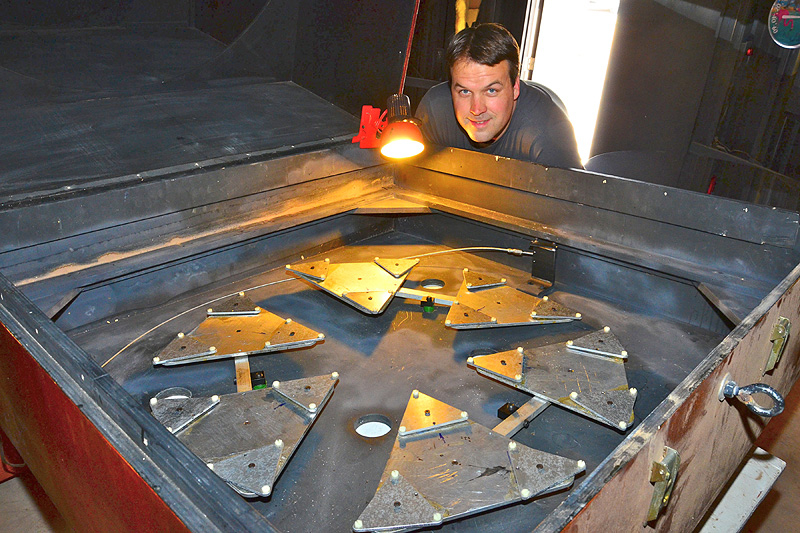 In the end, everything fit like a glove, and the only issue was that Tom managed to wedge his hand between the mirror and sling bracket as we man-handled the mirror back into place. Judging by the look on his face, it REALLY hurt, though he didn't manage to say it right away. We managed to help him free his hand after we realized what was going on. Luckily he was still able to play golf later that week, and he also had an excuse when he hit a bad shot! Well, the rain had followed me to Texas, so of course what happened after we reinstalled the mirror? Yes, you got it - the monsoons started.... and they didn't stop! 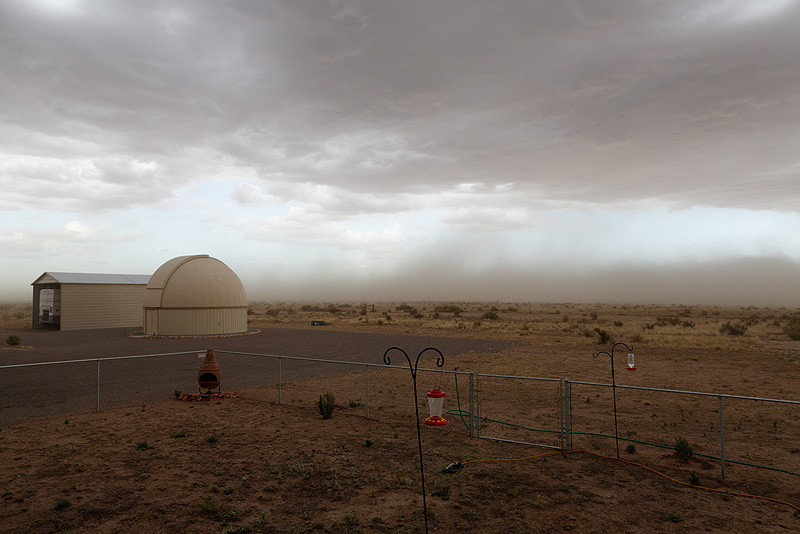 For a few days dust storms blew in from the north and east as powerful winds flowed out of building thunderstorms. An image of one storm is shown above. Eventually the rain reached the Clarks' place, but more annoyingly the clouds lingered through the night. Oh well, at least we could still play golf. ;) While waiting for the weather to improve, we enjoyed a couple of meals with Gary and Vandy and some other residents from nearby, some astronomers and some not. It is great to see some of the previous residents embracing the new direction that their community is going in, with that direction being darkness at night. After all, astronomers are very friendly people, they just ask for darkness at night. Photos of one gathering are below. 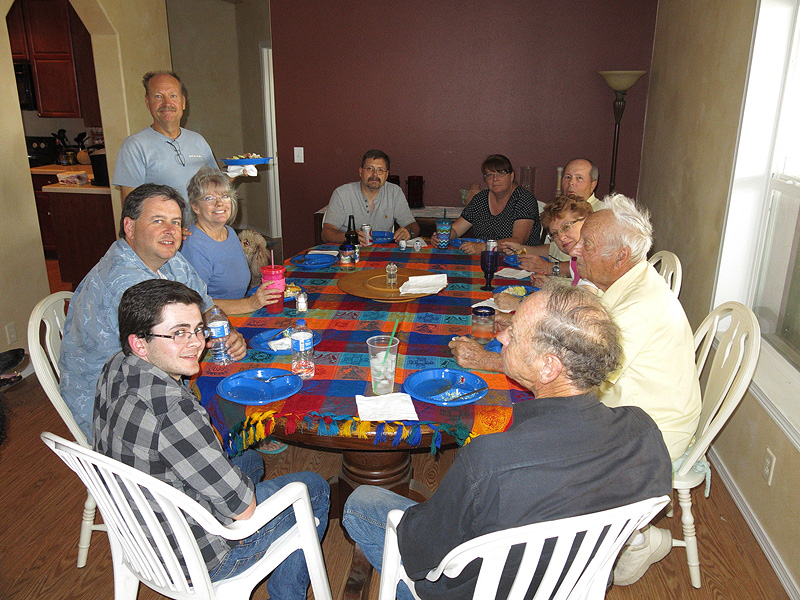 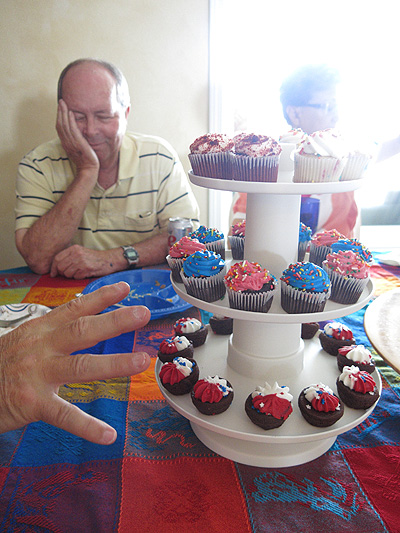 At left, Tom dozes after a nice meal while others are tempted by a tower of desserts. While I was there one evening after another excellent meal, were were sitting on Gary and Vandy's porch and literally watched as some unneccessary (but shielded) street lights, installed by a very non-astronomy friendly neighbor who had been renting a house, were turned off by the new residents who didn't wish to pay for the electricity to run them all night. We celebrated this small victory. One of the lights had actually been installed in a non-level manner, and was flooding the Clarks' bedroom window with unwanted light as well as part of their property and observatory. Finally, late in the week there were enough holes in the clouds to get a glimpse of the moon and Polaris. Another client and his wife were in town that evening for dinner and some observing. What did we see? We saw the roundest, tightest stars that I had ever seen through this 42" telescope. We were also treated to some highly detailed views of the moon, which I had no doubt were the finest lunar images that the telescope had ever produced. I was quite pleased with the dramatic improvement that had been brought about with a little bit of thought, a whole lot of convincing, about $50 spent (Tom had the metal and some other parts on hand), and one day's work. Unfortunately there was no more observing to be had for the rest of my visit, but it was nice to visit with other neighbors like Gary and Vandy and to see the progress they had made on their own home and other facilities. No doubt they will be featured in future articles that I will write about this up-and-coming community. We also did some target practice and quite a bit of relaxing, which was nice. No cats were harmed during my visit there. One afternoon a unique type of rainbow was observed in the desert sky, as seen in my image below over Gary and Vandy's compound. I've never seen a sundog like this horizontal one, but it must have had something to do with the cirrus clouds and ice crystals floating overhead. 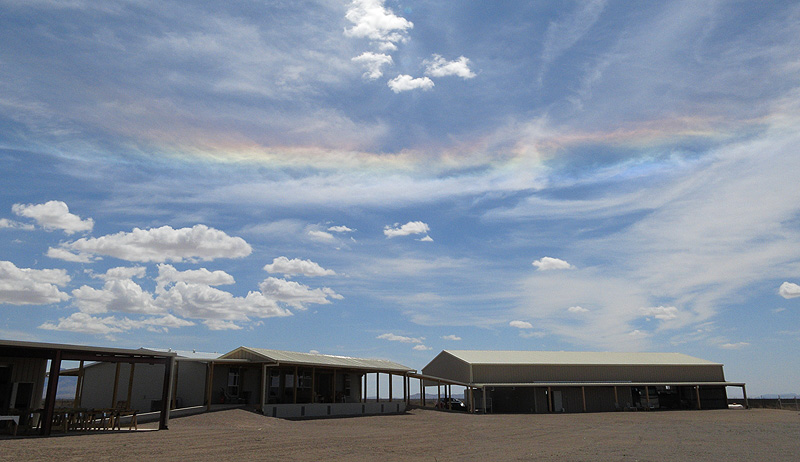 Soon, though, it was time to start heading home. I stopped by Doug and Christina's place near Albuquerque after a short day of driving, and we did a little observing the first night with Doug's refractor. 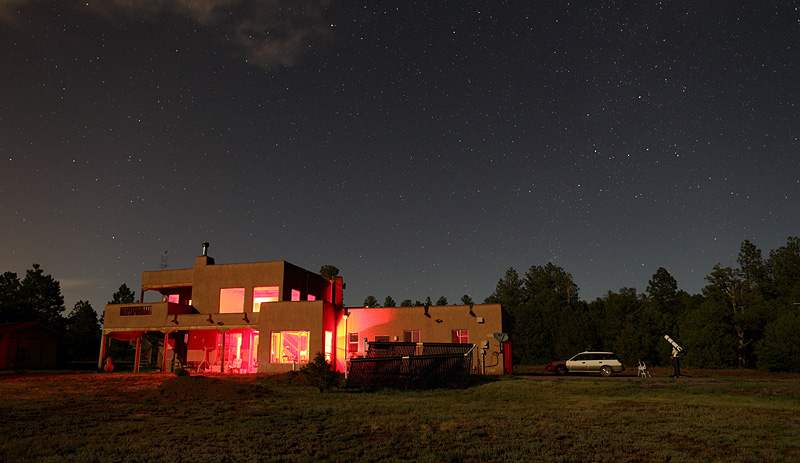 The next day we checked out Sandia Peak via the tramway, before I headed out in the afternoon to put some miles behind me. Albuquerque is seen below in in the image below, taken from the peak. 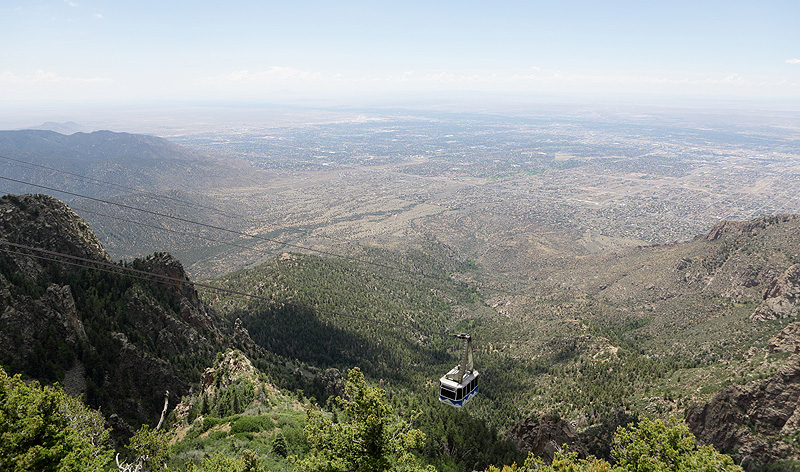 Further down the road, I stopped by Rick Singmaster's place on the way home, and then it was back to the shop to get some work done. I look forward to my next trip to the Three Rivers Foundation observing site and the New Mexico Astronomy Village. Now if I can just get Tom to add a little ventilation to his dome, things would be even better, but dust may prevent that. I suspect that will take at least a year or two to accomplish..... |
I look forward to my next trip to the 3RF observing site, the New Mexico Astronomy Village, and the Albuquerque area. Clear, dark skies, warm weather, good friends, good seeing, and cooperative monsoons. -Mike Lockwood, Lockwood Custom Optics |